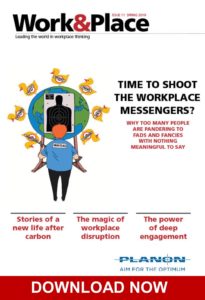Property Week’s recent co-working roundtable, which I was lucky enough to take part in, was one of the best discussions yet, with contributors from Workspace and WeWork among others that have really grasped what is happening in the market – namely a radical shift in mindset from a landlord- and investor-focused market to one that gives greater credence to the ‘client’ that occupies the space and the impact of brand on the sector.
So what does co-working really refer to?
The press still tends to view co-working as the tight, membership model of workers from different companies occupying a desk next to each other and doing so in a collaborative way. But this is all wrong. The market for co-working has evolved over time to encapsulate a variety of different services that now include serviced offices, executive suites and hybrid spaces all coming under the broader umbrella of flex space.
While the co-working market has grown relatively fast at 10%- plus each year, hybrid space has been expanding more quickly, at 20%-plus. Flexible office centres offering a hybrid solution now make up 15% of the industry, while those offering a traditional serviced environment fell to below 60% in 2018 for the first time.
The market is diversifying, not consolidating
Reading the mainstream press, you would think that WeWork and Regus were the only flex space operators out there, but this is a highly diverse marketplace. Independent operators make up a vast proportion of the market – 83% of operators of flex space in the UK are ‘indies’. The market share of the top 10 operators by size is actually decreasing as smaller players join this ever-evolving market and look to provide more diverse varieties of space.
Indie operators drove more than 30% of new supply to the sector in the established global markets of London, New York City and San Francisco last year. These new entrants also seem to be leading the trend of ‘niche-ification’, such as tech and female-only centres, providing spaces that cater to specific audiences and interests. As they are small and nimble, they can really customise their spaces to provide services to very specific markets.
The geographic spread of flex space is ready to change
London, NYC and San Francisco have been the growth cities for co-working in the past five years, but flex space is growing rapidly in second cities across the UK, the US and now mainland Europe. In fact, the real growth in supply and demand over the past year has come from Birmingham, Manchester, Oxford and Cambridge.
We anticipate that flex space will continue growing proportionately as part of the commercial real estate mix across the UK and it is our view that markets in these second cities that are going to provide the real growth in the coming years. With the cost of living only increasing in the capital as wages remain relatively static, working from one of the large regional cities two or three days a week makes financial sense.
Corporate requirements are changing the demand profile
Over the past five years, the flex space market has seen terrific progression as the wider real estate sector wakes up to the possibilities a more agile approach represents. In the UK and the US, clients are not only asking for larger requirements of flex space, they are also taking the space for longer. Nearly 50% of all flex space deals in the US are now for 18 months or more. Flex space is no longer seen as just a short-term fix.
Corporate occupiers are very much making their presence felt within the UK flex space industry. Between 25% and 30% of flex space in London is occupied by corporate organisations, with the proportion increasing year on year.
Moving forward
Flex space has quickly become the fast-moving end of the property market, where the customer (not the tenant) is right, and the end product has been created for a specific user base. As we move forward and more businesses demand a more flexible and agile approach to procuring office space, the commercial real estate market will need to adapt to the challenge of meeting consumer demand in a way it has never had to before.
The flex market provides space to its clients on their terms – flexible pricing, length of stay, choice of location, buying online and, yes, even free beer. Space blends with service to create a new approach to workspace and those that fail to adopt this new approach will very quickly get left behind.
John Williams is head of marketing at The Instant Group
Author:
Originally Published on November 29, 2018 at 06:23PM
Article published originally via “”flexible office”” – Google News https://www.propertyweek.com/insight/conventional-real-estate-has-totally-misunderstood-co-working/5100136.article




